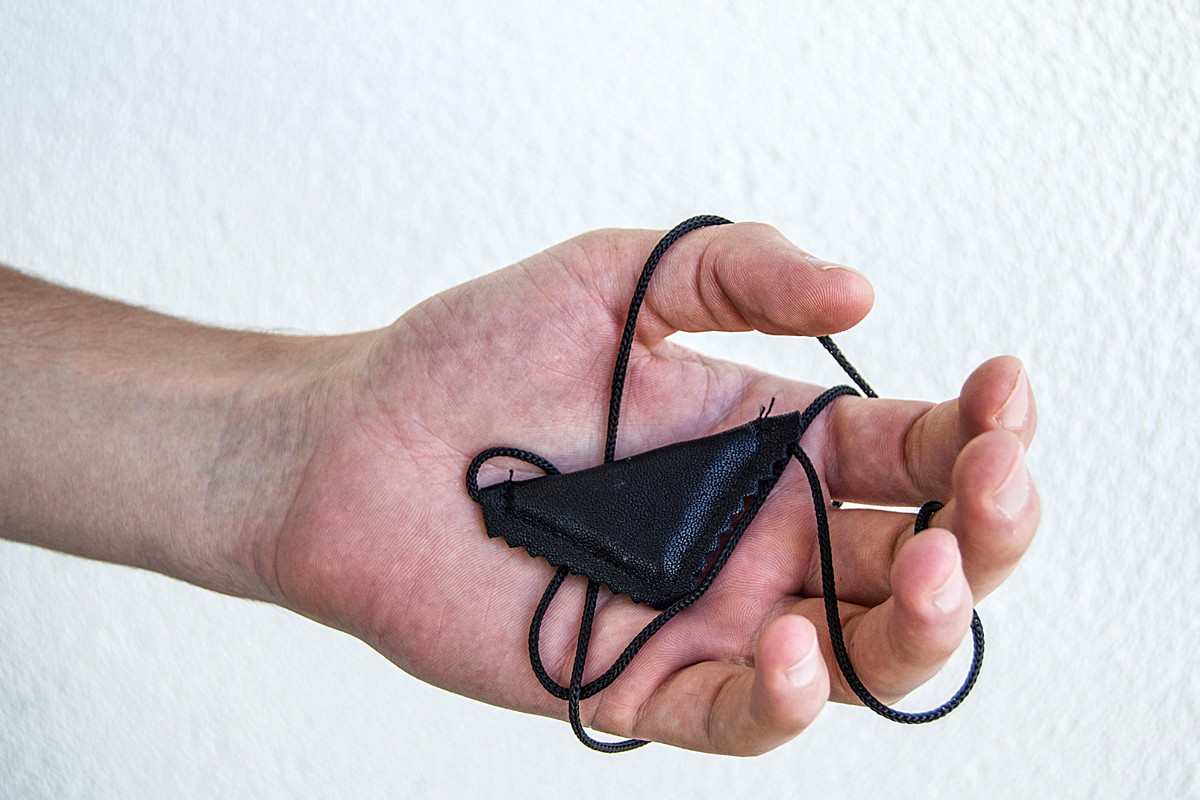How To Create A Magic Talisman

It’s common in many movies for the hero to have some type of magic object that helps him or her kill the bad guy. Harry Potter had his wand, Luke and all the other Jedi’s have their light saber, Lancelot had the sword from the stone. In this post we’ll learn how to build our own.
Companions
Even when we use a regular tool, we use a presupposition that suggests we think of tools as companions. We say, “I spread peanut butter on the toast with my the knife.” Or “I changed the TV channel with the remote.” The use of the preposition “with” indicates we think of this as a companion.
Linguistics To The Rescue
This was described in George Lakoff’s book, “Metaphors We Live By.” Lakoff demonstrated that whenever we use an intangible noun, we have to use it as if it were a real object. For example, we say we are in a meeting. But the meeting is really just a shared hallucination. It doesn’t exist as a thing.
There is a room, a table, some chairs, but those things are still there when there is no meeting. But we have to describe this shared hallucination as if it were a real thing. When say we are “in” a meeting, this indicates, according to Lakoff, that we think of the meeting as a container, since we use “in” with containers.
Lakoff postulates that “with” indicates a companion, which mentally is interchangeable with a tool, or more appropriately, a helper. I went to the prom with my girlfriend. I changed the tire with my friend. I took a picture of the UFO with my camera. I caught some fish with my pole. I caught some fish with my friend.
Metaphorical Helpers

It’s possible then that all those objects used by the hero’s in their hero’s journeys could be thought of as metaphysical or metaphorical helpers. Remember Dorothy? She thought the whole time that the magic shoes were what was going to get her home, but in reality she had that within her all the time. It could be all those magic objects were physical metaphors for their deeper skills.
The Anchor
This is a very common theme from NLP, but unfortunately it’s usually taught very inadequately. It’s taken from the idea of Pavlov and his dogs. Pavlov was able to take the smell of the food, and it’s effect on the dogs of making them salivate, and transferring that to the sound of a bell.
The way it’s usually taught in NLP seminars is a once-and-done type of thing. But when Pavlov did it, it took him a while. But even then it misses a lot of critical information if we want to build our own anchors. For example, Pavlov rang the bell when he brought the food. But he always brought the food at the same time.
If you’ve ever had pets, they get used to when it’s time to eat. Which means the dogs’ “salivation response” was probably pretty fired up anyway. So when Pavlov started ringing the bell at feeding time, their salivation response was already halfway there.
Best Ways to Build An Anchor
Despite anchors as being taught as nearly magical and instant in NLP seminars, consider taking plenty of time to build them. What we will be doing is finding a desired emotional state and connecting that anchor to a specific object. The idea being that whenever you would like that particular emotion, you need only touch that object. If that object happens to be a necklace, then just reaching up and touching it will give you shot of confidence, for example.
Not So Simple

The way anchors are taught, they seem to be able to give us, the person covertly setting the anchor on our friends, almost magical control over their emotions. But since you’ll be setting an anchor on an object you will be using to create emotions in yourself, we’ll actually have to take some time to do it correctly, and not just pretend to inside a goofy seminar.
Who Controls Your Thoughts?

Abe Lincoln famously said that we make ourselves as happy as we decide to. Meaning our emotions are up to us. That’s true, but it’s not so simple. We can’t just flip a switch and make ourselves happy. On the other hand, if you were walking down the street and a porn star walked up and handed you sack of money, you would probably become very happy very quickly. (So long as she didn’t just steal it and were using you as patsy).
So while it is possible to change our own feeling, it’s not so simple. But it can be through practice. On other hand, when unexpected things happen, it can change our feelings in a hurry. In order to build up a very strong anchor to an object, it will take a lot of practice.
Step One – Choose The Desired Emotional State
Take some time with this. Choose on that is as specific as you can. “Confidence” is extremely vague. Choose a very specific one like, “Confidence when selling things,” or “confidence when asking pretty girls for their phone number.” This process does take time, but with enough patience, it’s very possible to slowly build up a whole collection of talismans that you can use in very many different situations.
Step Two – Choose The Object

This should take just as much time. Ideally it should be a piece of jewelry or something you can keep close, and touch in the middle of a conversation. A bracelet or a necklace are perfect. Choose something that will only be used in this situation. Don’t attach a whole bunch of different emotions to your watch, for example.
Step Three – Build The Anchor
This will take the longest time. Give it a couple of weeks. The more time you take building this, the stronger it will be. Only start this process when you’ve actually got the object.
Journal Previous Experiences
Start off as young as you can remember, and write down one experience where the desired emotion was fully present. Don’t just close your eyes and think for a couple seconds. Write out, long hand, as much detail as you can regarding a previous experience where you felt this specific emotion. Write it out with your writing hand while tightly holding your object in your other hand.
Repeat Daily For One Week
Do this every day for at least one week. Do not look at or touch your object unless you are writing out an actual experience of the target emotional state. Each time you do this, the feeling of that emotion upon touch and feeling your object should begin to strengthen.
Review Each Written Scenario Before Writing Another One
Each time you write out another memory, take time to slowly review the previously written memories while holding your object. This will “charge it” as well as help you recall another similar experience with the same emotion.
Practice In Social Situations

Once you’ve built in at least a week’s worth of journal entries, try your talisman out in public. You will need to be very specific how you handle your talisman away from your home. Put it on, and ignore it as much as possible. Go into a few social situations, and then slowly and consciously reach up (or over) and hold your talisman. Purposely recall the events you journaled. Don’t expect this to be a magic event, you will need to fully participate by consciously recalling all of the previous experiences.
Practice Charging While Writing
You can think of going out in public and purposely creating the feeling of confidence (or whatever emotion you are building into your talisman) as also charging it. When you create the feeling in an actual social situation, it will being to reinforce itself. That social situation can now be an effect of a previous memory, but it’s also a cause of a new memory.
Recall Before Touching
Another way to do this is to get yourself into a social situation, and purposely recall a memory before touching your talisman. Once you feel the confidence bubbling up, attach it mentally to somebody, or more effectively somebody around you. Once you’ve set this connection, then reach up (or over) and touch your talisman.
Re-Charge and Trigger Consistently

Eventually you’ll get to the point where you don’t need to do any more writing. Essentially your talisman has become a transition element between all your memories and new experiences. You can view the writing phase as bringing specific memories up from your memory, while connecting to the physical talisman.
Once you’ve got enough of them transitioned, then you go out and feel it and the feelings while being in social situations. Once that becomes easy, then you feel the confidence first, by purposely remembering all your journaled entries, connect that feeling to something in the environment, and then connect that to your talisman. When you reach this step you can now continue to charge your talisman by first feeling confident in social situations, and then charge it.
The Money Shot
Now that you’ve taken plenty of time to charge your talisman (which should be maintained regularly just like any practice) you are now able to use it in “emergency” situations. It’s easy to feel confident when you can predict what’s going to happen. The whole point of developing confidence is to feel it when you need it, which is usually when it’s least expected.
Create Mental Space
Understand the world will deliver a situation into your lap that will require proper confidence to respond to and take advantage of. When that happens, just give yourself a quick moment, take a breath, reach up or over and grab your talisman briefly. The more you build in a specific emotion, the more powerful the instantaneous surge of confidence (or other emotion) will give you.
We all know what it’s like to have the opportunity of a lifetime materialize unexpectedly, only to stand there wishing we knew how to handle it while the opportunity walks away. If you take the time to build a powerful talisman, this never needs to happen again. Once you see an opportunity, all you need is a breath, create some mental space and the talisman will do the rest.
Pre Framing With A Time Line

If you have a big event coming up which will require the emotional resource you’ve programmed into your talisman, you can prepare for it using a time line. Find a large open space where you can slowly walk and imagine with your eyes closed without worrying about any social pressure.
Laid Out Before You
Put the future event ahead of you by a few yards. Close your eyes and imagine a timeline laid out in front of you. Imagine the physical area where the future event will take place. Physically walk forward, imagining you are going forward in time into the time and location where the future event will take place. Slowly reach up and hold your talisman as you do so.
Go slow and imagine the event in as many ways as you like. The physical act of slowly walking forward will help you prepare for the actual event. Most events involve you walking forward, either up to a podium or across a room to talk to somebody. By mentally and physically preparing, you can easily recall both as you mentally and physically approach the actual event.
Slowly Build A Talisman Collection

This will take plenty of time. Give yourself at least a couple of months to build one strong talisman for one resourceful emotional state. This will allow you to respond much more powerfully to unexpected events, any one of which can easily transform your life in unexpected ways should you handle it correctly.
Once you’ve got one talisman built, consider building another one. Once you get the procedure down, there is really no limit to the anchors you can build for yourself. Intelligence, memory, wit, humor, seductive prowess, the list goes on. You can even get ideas from your favorite fictional characters.
Any time you see or read about a fictional character performing in a way you’d like to emulate, identify the underling emotional resource state and get busy building a talisman. Eventually you can build yourself whole collection of heroic tools as you take with you as you go out and conquer life.
Learn More

Mind Persuasion has plenty of books and courses all designed to help you get much more out of life with much less effort.
Mind Persuasion Books
Mind Persuasion Courses